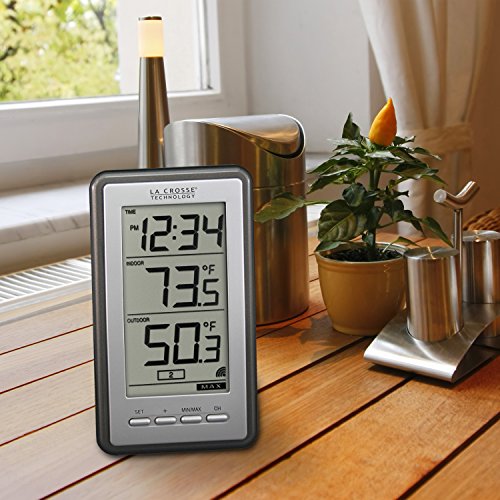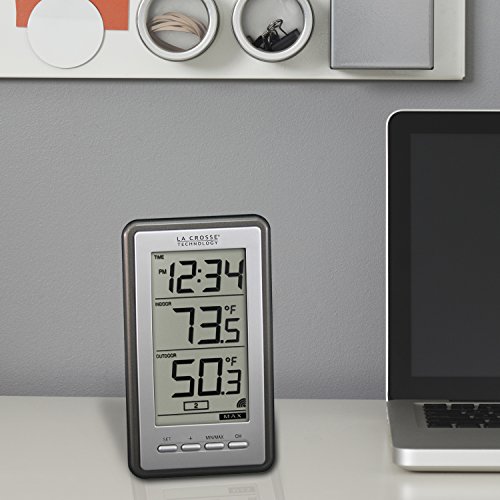Weather has been more extreme lately. Summers have gotten intensely hot – even for those of us who can take it – and winters are trending much colder. It can be difficult and expensive to constantly react to these changes, never knowing whether a day will be temperate or extremely hot or cold.
That’s why a lot of people are turning to wireless indoor outdoor thermometers to reliably control their environments. This guide will help you learn what to look for when making buying decisions then give you a shortlist of our proven favorites to narrow down your search for the perfect option.
Buyers Guide
Before you decide what thermometer to buy, you should be familiar with how they work. They’re not the same as classic old school options. Let’s take a look at some of the things you need to think about when it comes to these high tech thermometers.
Features
The one thing everyone loves when it comes to technology is features, features, features. Upgrades should come with more things, more knowledge, and more functions, right? Be careful not to get too carried away in the spirit of upgrades and gadgetry. You want to consider the right features for your needs and how they affect the display.
Pro Tip: As a general rule of thumb, the more features your weather thermometer comes with, the harder it will be to read or understand each individual piece of data.
See, all the extra features crowd a display screen. They also cost a lot more money. So, while it might be tempting to buy the thermometer with humidity monitor, it won’t likely have much of an effect on your life unless you live in a particularly humid area.
Likewise, a lot of people don’t really understand barometric pressure, so why even include it? Generally, high barometric pressure readings tend to mean sunshine and low-pressure areas will end up with clouds. This feature is rarely useful unless you live in an area with pretty unpredictable local weather.
Display Screen
One of the critical components to consider when buying one of these thermometers is the display. This is also one of the most variable factors and likely the most important distinguishing feature between many similar models. You need to choose a display that works well for you.
Are you planning to check the temperature frequently at night? Are you installing it in a shady or dimly lit area? You may want to consider a display console with a backlight.
If you do want to go all-in when it comes to features, consider purchasing a thermometer with a larger display so that the numbers won’t be too confusing. Or, go for a model with a few buttons to toggle between displays so all your data isn’t stuffed into one small screen.
If your vision isn’t great or there are older people living with you then you may want to consider a larger display screen so that everyone can clearly read the big numbers. If you’re more of a minimalist and your house is modern and uncluttered, a smaller unit might be your best option.
Location
Location is also important. If you’re using a wireless thermometer, you need to make sure it can easily access the router. Remember to place it in an area that can access the wireless for updates.
You also need to consider location when making a decision on the display because your thermometer has to fit where you want it to go. It also wouldn’t hurt for the unit to blend seamlessly with your décor instead of sticking out of an otherwise beautiful room like a sore thumb.
When it comes to placement, the outdoor sensor should go at least 6 feet above the ground. It also has to be placed so it isn’t directly in sunlight or unprotected from rain or it won’t give an accurate reading. It should be placed somewhere with good airflow. Don’t put the wireless sensor near metal, either, or you’ll end up blocking its access to the wireless signal.
Thermometer Reviews
Now that we’ve covered the basics, it is time to share our picks for best weather thermometer with you. Two thermometers on the market tied for our favorite indoor outdoor wireless thermometers. Buying either of these products means that you don’t have to worry or stress about whether you bought a decent thermometer. One of them was chosen for its sleek display and range and the other was picked for the features.
LaCrosse Technology Indoor/Outdoor Temperature WS-916OU-IT Digital Thermometer
Prices pulled from the Amazon Product Advertising API on:
Product prices and availability are accurate as of the date/time indicated and are subject to change. Any price and availability information displayed on [relevant Amazon Site(s), as applicable] at the time of purchase will apply to the purchase of this product.
The La Crosse is the best looking option. The modern grey and silver color scheme looks great with the sleek display console. It’s a large display with clear and easy-to-read numbers. Plus, it’s small and portable so you can take it with you throughout the house.
The display is not loaded with features. It simply and attractively shows the time with both the outdoor and indoor temperatures. The model also allows for the addition of two additional sensors (sold separately) for more accurate outdoor temperature readings. It records the minimum and maximum temperature data each day.
One of the truly impressive features of this model is that it will update every 4 seconds from 300 feet away.
AcuRite 00611 Indoor Outdoor Thermometer with Wireless Temperature Sensor and Hygrometer
Prices pulled from the Amazon Product Advertising API on:
Product prices and availability are accurate as of the date/time indicated and are subject to change. Any price and availability information displayed on [relevant Amazon Site(s), as applicable] at the time of purchase will apply to the purchase of this product.
The AcuRite comes pre-calibrated so you don’t have to worry about doing it yourself. It has a large, easy-to-read display screen that shows the humidity and temperature readings and lets you know the signal strength. This model does not display the time.
While most people concern themselves with outdoor humidity, knowing the inside humidity can be very useful. It can give you early warning signs for health hazards like mold growth and asthma triggers that can result from high humidity or throat and nose irritants from low humidity. This model reports data every 30 seconds from a range of 150 feet so what you gain in humidity readings, you sacrifice in range and timeliness.
















